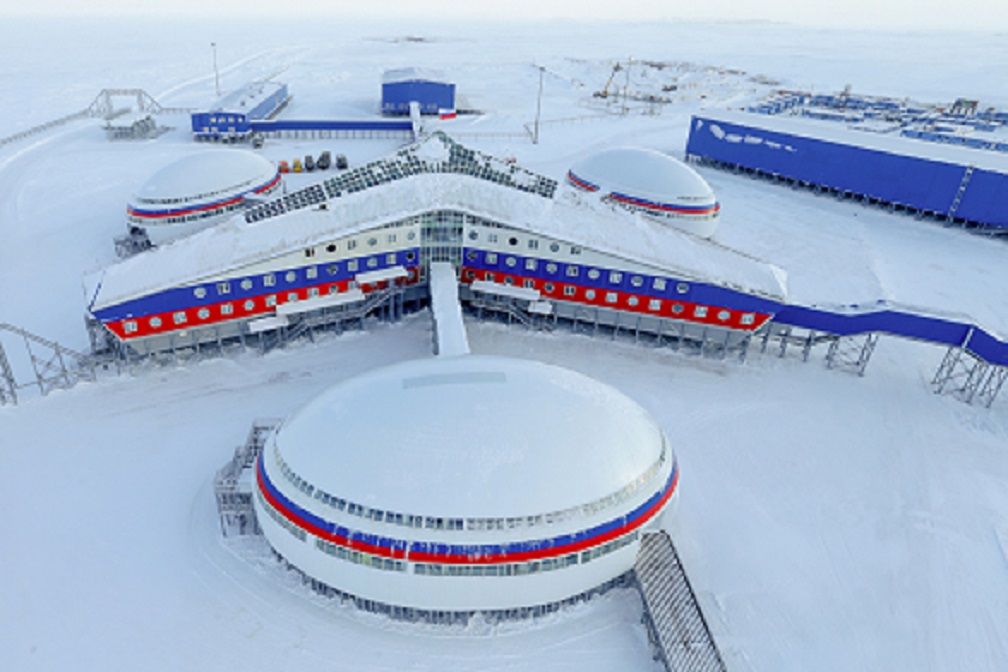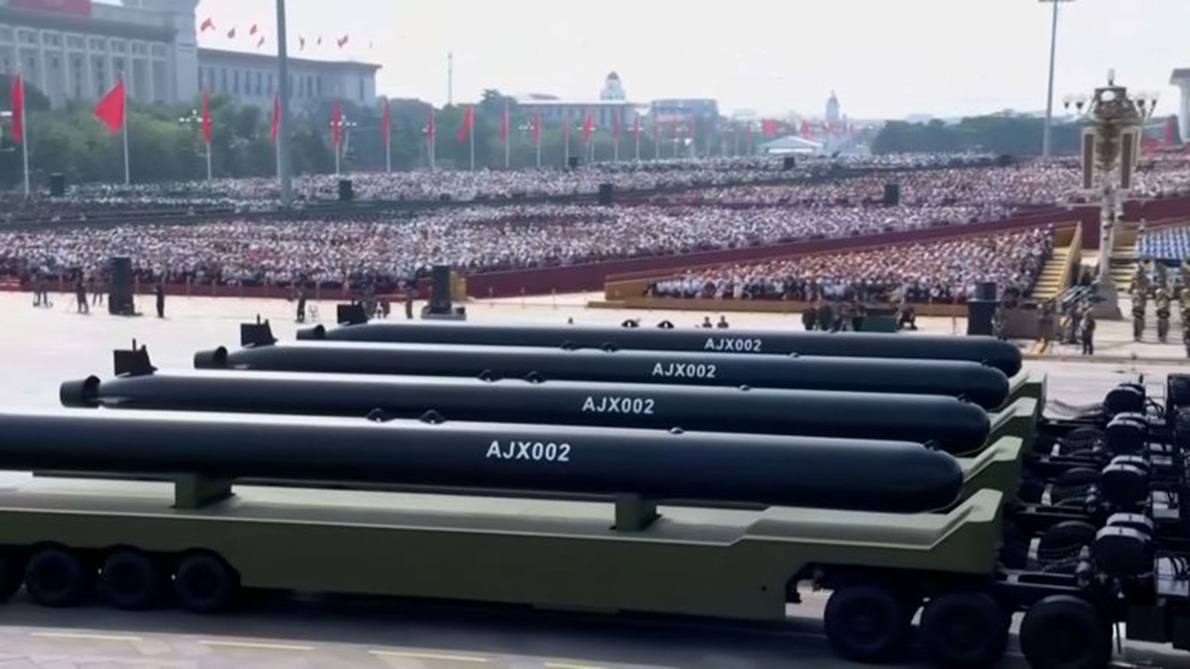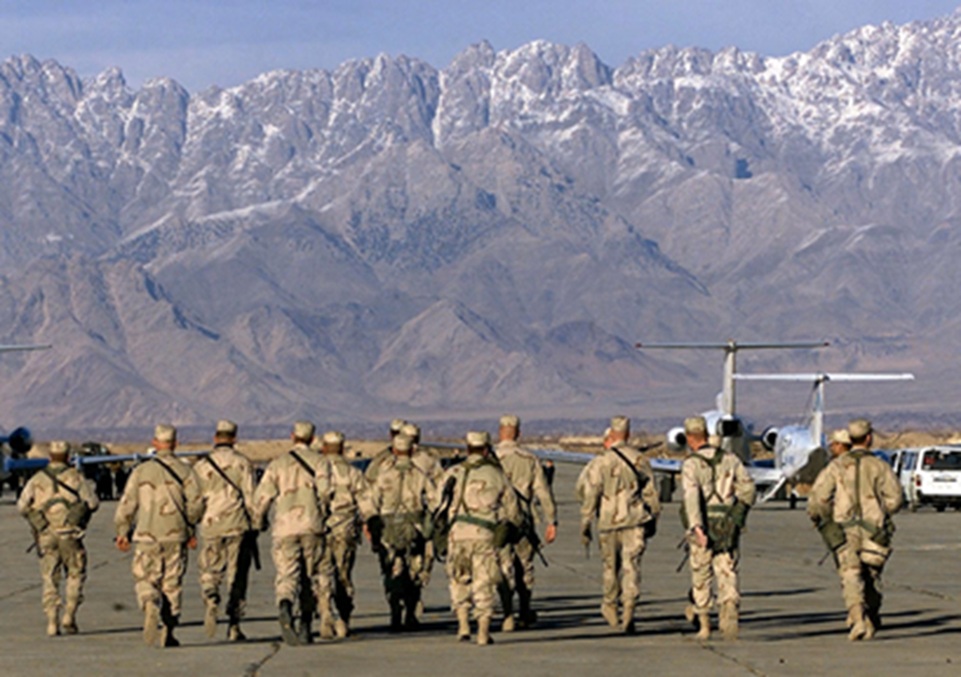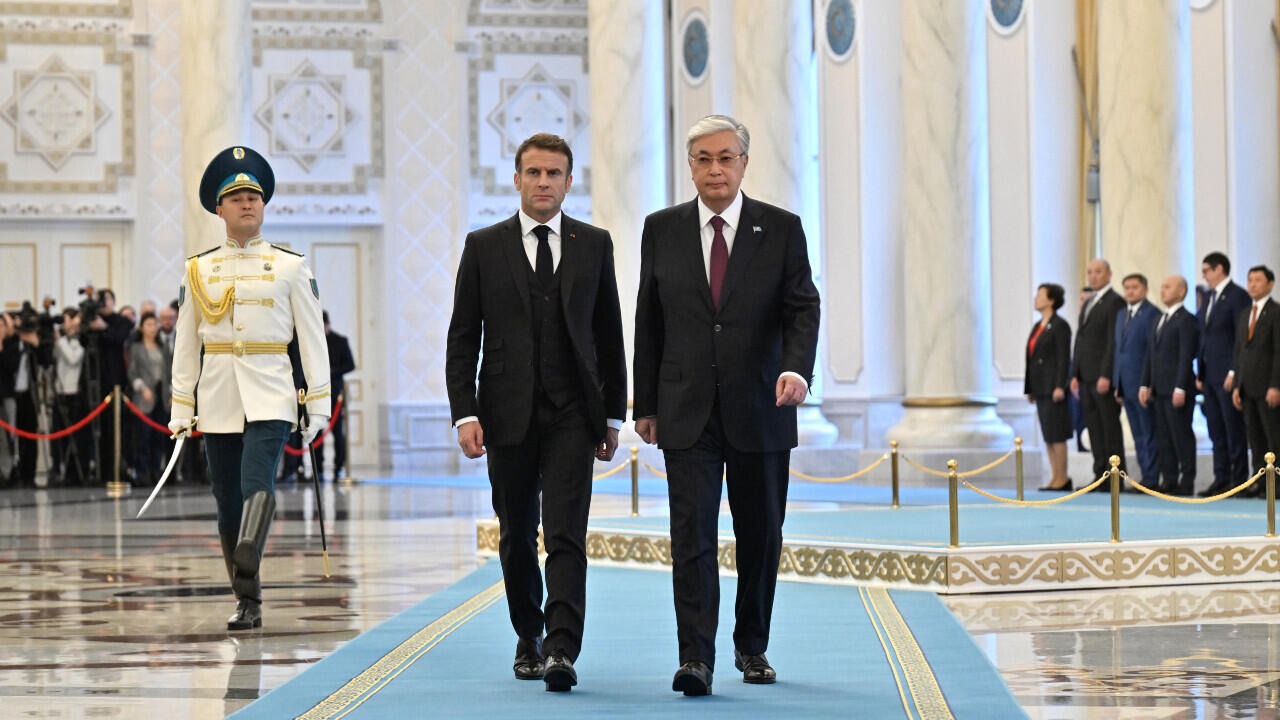The security environment in and around the Arctic is becoming increasingly militarised and dangerous. In March this year, 20,000 NATO troops conducted the largest ever war exercise named “Joint Viking” and “Joint Warrior”, in the Arctic. including Finland and Sweden also participated. Finland has become a member of NATO while Sweden’s membership is under process. Simultaneously, about 19000 soldiers of France carried out the biggest manoeuvre in the last 10 years by “Orion 23” related to the war exercise; 600 German soldiers practised the defence of Lithuania in an exercise called “Griffin Lightning”.” NATO classified this exercise as a defensive exercise. [i] Obviously, this exercise was the latest in the chain of exercises that have been regularly organised and demonstrate the strategic significance of the Arctic.
The Russian Arctic, in fact, is an immense territory that stretches over 24,150 kilometres of coastline and includes: the whole of the Murmansk Region, the Nenets, Yamal-Nenets, and Chukotka Autonomous Okrugs, and the Komi Republic; the northern municipalities of the Arkhangelsk Region, Krasnoyarsk Krai, the Republic of Sakha (Yakutia) and the Republic of Karelia and the archipelagoes and islands in the Russian portion of the Arctic Ocean.
In fact, Russia stretches over 53 percent of the Arctic Ocean coastline. Approximately two and a half million of Russia’s inhabitants live in Arctic territory, accounting for nearly half of the population living in the Arctic worldwide. [ii]

Russia sees its vast Arctic territory, therefore, as a vital strategic interest and has been building up its military capabilities in the region for years, obviously responded as ‘belligerent activities’ by the West.
The Arctic region is strategically very important in terms of energy, trade, and security. America, China, and other countries are engaged in increasing their control in this region. Ukraine is about 5727 kilometres away from the Arctic region. The heat of the conflict is visible in the Arctic. It is well-accepted that the centre of the next cold war is the Arctic.
To remind you, the Ukraine crisis has had an impact on the functioning of a number of multilateral organisations including the Arctic Council. The functioning of it is paused since 04 March 2022. The Arctic Council consists of eight Arctic States; Canada, Denmark, Finland, Iceland, Norway, Sweden, Russia, and the U.S. [iii] The Chairmanship of the Arctic Council rotates every two years among the Arctic States. Russia is the Chair of the Council (2021-2023) at present. [iv]
Interestingly, Russia has taken the Presidency of the UN Security Council in April 2023 for a month as the provisions of the UN. The last time Russia had the Presidency was in February 2022 when it began ‘military operations’ in Ukraine.
The fallout of the current Russia-Ukraine crisis on the Arctic in the form of increasing militarisation has turned the region into almost a war zone. Eurasian Times reported on 23 October 2022, titled “US, Russia Boost Military Presence Around North Pole; Experts Say After Ukraine, Arctic Could Be The Next ‘Battleground,” [v]
The Emerging Polarised Geo-Politics of the Arctic
The Russia-Ukraine armed conflict has polarised the power players. The U.S. has been successful in keeping the EU nations with Australia, Canada, etc nations together against Russia and has claimed to isolate Russia from Ukraine. While Russia has gained leverage in Africa, Iran, India, and China maintaining trade in spite of sanctions. Russia has organised military exercises too in which the countries of Asia-Africa-Latin America participated. India is maintaining its neutral status and appealed for peace many times. Due to this unexpected long-drawn battle, the militarization of the Arctic, Black Sea, and adjoining region are increasing. The threat of World War III is also anticipated. The threat of the use of Nuclear weapons has also turned the political environment nervous. Thus, the geopolitics of the Arctic region has been seriously jeopardised. Since, the Arctic has huge energy storage of natural gas, oil, hydrocarbons, etc. and Russia is the largest Arctic State based on size, population, and military forces stationed in the region, therefore, the Arctic is considered the next battleground after Ukraine. The U.S. and Russia, the two biggest nuclear power, and China an emerging world power are engaged in war-like preparations in the region. [vi]
Increasing Military Activities by Russia
Russia sees its vast Arctic territory as a vital strategic interest. Russia, therefore, has been building its military capabilities in the region. Russia 2022 established a new “Arctic command” and four new Arctic brigades, while renovating airfields and deep-water ports in the region. [vii]
In September 2022, Russian organised a large-scale military drill named UMKA-2022 in the Chukchi Sea an eastern stretch of the Arctic Ocean that separates Russia from the Alaska region of the U.S. In this exercise, Russian nuclear-powered submarines – the Omsk and Novosibirsk – demonstrated their capabilities and fired anti-ship cruise missiles from the Chukchi Sea, hitting targets at a distance of 400 kilometres (250 miles). [viii]
Russia also conducted military exercises on 01-07 September 2022, in Russia’s Far East named Vostok 2022. This exercise was conducted at seven different places simultaneously. It was reported that about 50,000 troops, 5000 units of weapons and military equipment, 140 aircraft, 60 warships, and military boats-vessels took part in the exercises. [ix]
President Putin himself observed this exercise which shows the strategic preference of the Arctic region for Russia. It is also significant to note that the army contingents from Azerbaijan, Algeria, Armenia, Belarus, India, Kazakhstan, Kyrgyzstan, China, Laos, Mongolia, Myanmar, Nicaragua, Syria, and Tajikistan also participated in this military drill. [x] It demonstrated that Russia is not isolated and Russia was trying to strengthen its relationship with the Central Asian and South East Asian countries including India.
The gap between Russia and America -West is gradually growing. President Vladimir Putin on 31 July 2022 signed a new naval doctrine that recognises the United States as Russia’s main rival. The doctrine specified Russia’s global maritime ambitions in the Arctic and in the Black Sea. [xi]
The Doctrine sees the present status of the world as dangerous. The Doctrine claimed the revised Security Strategy of Russia and identifies the increased number of Russia’s national interests in the World’s Oceans, from eight to fourteen. The development of the Arctic zone of the Russian Federation (AZRF) and the Northern Sea Route (NSR) has been added to the list of national interests. [xii] Thus, geopolitical reasons have placed the Arctic as a priority region for Russia.
Russia has natural dominance in the Arctic region. The ongoing gas and energy trade tensions between Russia and the European Union, the increasing energy trade of Russia with China and India, China’s new trade energy relations emerging with the West, and the growing demand for such trade in local currency are the factors that have affected international order. Since the Arctic is a vital source of Russia’s energy supply, its militarisation is also followed by Russia. In response, the U.S. is also increasing and expanding its military muscles in the Arctic where most of the regional countries are members of NATO.
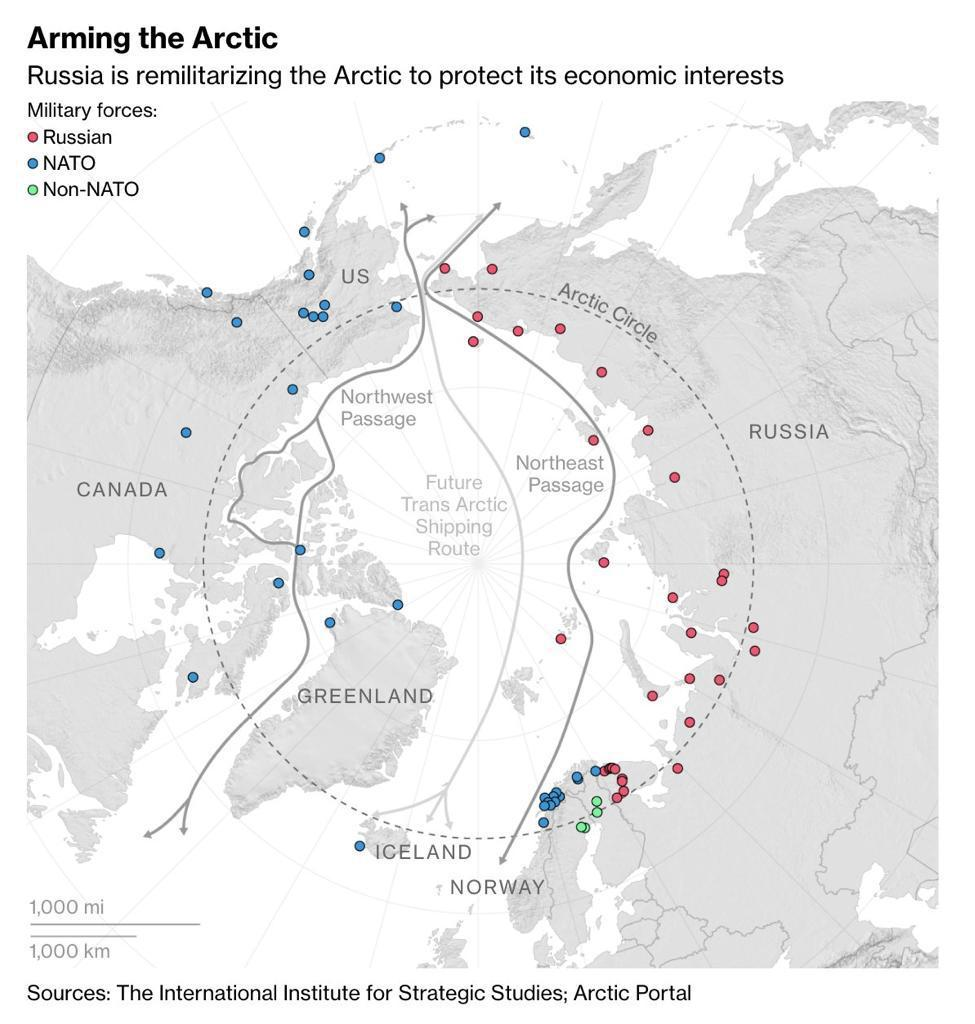
Militarisation by the US
The Russia-Ukraine conflict has involved all the Arctic States. The six members of the Arctic Council, Finland is the latest, are NATO members. Sweden’s membership to the Alliance is under process. The EU-U.S. and NATO are regularly supplying Ukraine with arms and other military equipment, therefore, the conflict has become a part of power competition in the Arctic.
The Chair of the NATO Military Committee, Admiral Bauer during the Arctic Circle Assembly meeting on 14-15 October 2022 in Iceland has also expressed that once Finland and Sweden join the NATO Alliance, seven of the eight members of the Arctic Council will be NATO Allies then, obviously, NATO’s role in the Arctic region will be more strengthened. [xiii]
On this pattern, the Pentagon announced on 07 October 2022 that it has established an Arctic Strategy and Global Resilience Office which would be led by Iris Ferguson as Deputy Assistant Secretary of Defence for the Arctic. She will oversee several elements of the White House’s Arctic strategy, such as coordinating with U.S. security partners and forcing the modernisation of U.S. forces. [xiv]
On the same day, the U.S. released its ten years vision on “The National Strategy for the Arctic Region” which reflected the U.S. force’s modernisation strategy. [ xv]
The document focuses on the increasing strategic competition in the Arctic. The document is of the opinion that Russia’s invasion of Ukraine and the Chinese advances in the Arctic region have compelled the U.S. to increase its military presence to counter this threat. The Chinese identification as a “near Arctic” country and its ambition to build the “Polar Silk Road” through the Arctic is a cause of concern. [xvi]
The U.S. document revealed that over the last decade, China has doubled its investments, with a focus on critical mineral extraction; expanded its scientific activities; and used these scientific engagements to conduct dual-use research with intelligence or military applications in the Arctic.
The document also acknowledges that Russia has reopened and modernised hundreds of Soviet-era military bases in the region in the last ten years. The new strategy highlights that Moscow is “deploying new coastal and air defence missile systems and upgraded submarines; and increasing military exercises and raining operations with a new combatant command equivalent for the Arctic.” In response, the document declared that the U.S. will increase its military capability in the region. It is significant to note that the U.S. keeps more than 22,000 active-duty troops in Alaska and also has a base in Greenland. [xvii]
The Biden administration also released an 80-page unclassified National Defence Strategy on 27 October 2022 which claimed to be aimed at China and Russia. The document views China strategic competitor, and Russia as an “acute threat” capable of cyber and missile attacks on the U.S. [ xviii]
The US administration also released the classified Nuclear Posture Review with National Defence Strategy for the first time. Its publication was substantially delayed, likely due to Russia’s invasion of Ukraine. Unlike previous NPRs, the 2022 version is embedded into the National Defence Strategy document alongside the Missile Defence Review. The unclassified version of the Nuclear Posture Review stressed on nuclear warfare mechanism. [ xix]
The NPR document gives special importance to raising robust nuclear command, control, and communications through satellites and cyberspace so that the U.S. army can contain Russia and China which are also big nuclear power. [xx]
The longevity of the Russia-Ukraine conflict has gradually raised the threat of the use of nuclear weapons and it is projected in recently released defence documents. President Putin had already warned in September 2022 that he would use nuclear weapons to defend Russian territory after annexing four regions of Ukraine. The Russian Ministry of Defence has already conveyed to the world that it had information about the Kyiv regime’s planning to commit a provocation by exploding the so-called “dirty bomb” or low-power nuclear warhead. [xxi]
In addition to the nuclear threat, the new era of weapon technology like supersonic weapons and drones is also highlighted in the Russia-Ukraine conflict that has triggered the militarisation of the Arctic region.
The use of drones in modern warfare also came on the front in the Russia-Ukraine conflict under the most modernised weaponry. The Russia-Ukraine war has shown that combat drones are becoming the new normal on the battlefield. [xxii]
To recall, Ukraine has carried out a “massive” drone attack on the Black Sea Fleet in the Crimean port city of Sevastopol as Russia alleged, damaging one warship. Nine drones were said to be used as BBC reported. [xxiii]
The next example of the importance of drones may be found in the US Army Declaration on 24 October 2022 at the Annual AUSA (Association of the United States Army) Meeting to replace Shadow 200 is the smallest of the Shadow family of unmanned aircraft systems developed by AAI. It is in operational service with the US Army and US Marine Corps. [xxiv]
Beyond drones, the U.S. has already declared its initiation of obtaining next-generation weaponry. In September 2022, the Under Secretary of the US Army, Gabe Camarillo announced that the first American hypersonic weapon to boost next-generation battlefield capabilities in addition to 24 new systems would continue to be deployed as planned in 2023 under a massive modernisation plan. [xxv]
Chinese Xingkong-2 and Dongfeng-17, hypersonic weapons, and Russian Kinzhal have already been demonstrated. [xxvi] The use of hypersonic weapons may change the nature of today’s warfare as drones have done today. The modernisation of weapons is also becoming significant with the expansion of the conflicts. The rivalry may not be confined to a limited region. Geopolitics obviously expands the interests, cooperation, coordination, and conflicts too.
The militarization of the Arctic has become more sensitive, therefore, with the expansion of the Russia-Ukraine military conflict from the Arctic to the Black Sea region. Ukraine’s trade happens through the Black Sea. The Black Sea region is considered Russia’s gateway to other regions such as the Eastern Mediterranean, the Middle East, and Africa. Russia has already annexed almost 20 percent of Ukraine’s territory linking southwestern Russia to the warm water ports of the Black Sea. The result is the Black Sea region has become a centre of power rivalry and the militarisation linked with the Arctic region.
The U.S. Secretary of State Mr Antony J. Blinken and Romanian Foreign Minister Mr Bogdan Aurescu at a Joint Press release on 29 November 2022 said that the U.S. will consolidate the allied defence and deterrence position in the region of the Black Sea. Thus, the Russia-Ukraine military conflict has aggravated militarisation from the Arctic to the Black Sea region. [xxvii]
Thus, the defence documents of Russia and the U.S.-Russian Naval Doctrine, the U.S. strategy document on the Arctic, the National Defense Strategy, and the National Posture Review – perceive each other as main rivals. Both sides’ documents show renewed and increased power rivalry, that became more highlighted after the Russia-Ukraine military conflict. The power blocs’ rivalry and military competition are leading them to acquire more modernised weaponry and make forces more professional for nuclear warfare. The Russia-China proximity that was displayed at President XI’s visit to Russia in March 2023 further polarised Russia-West relations with China seems at the Russian side.
These developments have led some experts to comment that there is a gradual increase in the importance of the Arctic within the military strategy of the Arctic nations and it might in the future lead to an increase in military presence in the region. Thus, the militarisation by the U.S. and Russia is growing in the midst of the Ukraine conflict which heating the Arctic environment.
Conclusions
The demand for peace is being pushed but neither side is seen to be ready for diplomacy and establish peace. Both sides want security assurances and allege one other to jeopardise it. The U.S. and Western countries are arming Ukraine to counter the Russian offence. The Russian forces have captured about 20 percent of the area of Ukraine. It is assumed that this conflict basically originated from the power competition in the Arctic region which has rich energy resources. It is, therefore, perceived that this conflict may spread to the Arctic region where local countries are NATO members, Finland is the latest. In the age of globalisation and an interdependent world, the increasing militarisation of the Arctic region is revealing nervous and confusing signals that worry the world.
Title image courtesy: Wikipedia
Disclaimer: The views and opinions expressed by the author do not necessarily reflect the views of the Government of India and Defence Research and Studies
Endnotes:
[i]. https://www.nato.int/cps/en/natohq/news_212791.htm
[iii] Arctic Council, https://arcticportal.org/arctic-governance/arctic-council
[iv] Arctic Council, https://www.arctic-council.org/about/russian-chairmanship-2/,
[v] US, Russia Boost Military Presence Around North Pole; Experts Say After Ukraine, Arctic Could Be The Next ‘Battleground’,
[vi] Matthew Melino & Heather A. Conley. THE ICE CURTAIN: RUSSIA’S ARCTIC MILITARY PRESENCE.
https://www.csis.org/features/ice-curtain-russias-arctic-military-presence
[vii] Melissa Rossi. Russian military moves in the Arctic worry the U.S. and NATO. https://news.yahoo.com/russian-military-moves-in-the-arctic-worry-the-us-and-nato-090027224.html
[viii] Russia With Military Exercises in Ocean Vis-à-Vis Alaska,
https://www.highnorthnews.com/en/russia-military-exercises-ocean-vis-vis-alaska
[ix] Putin attends Vostok-2022 military drill in Russia’s Far East,
https://www.aa.com.tr/en/world/putin-attends-vostok-2022-military-drill-in-russias-far-east/2678205
[x] Ibid.
[xii] Ibid.
[xiii] Chair of the NATO Military Committee highlights the strategic importance of the Arctic(14 Oct. 2022 – 15 Oct. 2022).
https://www.nato.int/cps/en/natohq/news_208099.htm
[xiv] DOD Establishes Arctic Strategy and Global Resilience Office (Sept. 27, 2022). | By Jim Garamone, Department of Defence News | https://www.defense.gov/News/News-Stories/Article/Article/3171173/dod-establishes-arctic-strategy-and-global-resilience-office/
[xv] https://www.whitehouse.gov/wp-content/uploads/2022/10/National-Strategy-for-the-Arctic-Region.pdf
[xvi] Ibid.
[xvii] White House Arctic strategy calls for enhanced military presence(October 7,2022) By Bryant Harris https://www.defensenews.com/pentagon/2022/10/07/white-house-arctic-strategy-calls-for-enhanced-military-presence/
[xviii] Department of Defense Releases its 2022 Strategic Reviews – National Defense Strategy, Nuclear Posture Review, and Missile Defense Review(Oct. 27, 2022) https://www.defense.gov/News/Releases/Release/Article/3201683/department-of-defense-releases-its-2022-strategic-reviews-national-defense-stra/
[xix] Nuclear Posture Review – DoD – Department of Defense https://dod.defense.gov/News/Special-Reports/NPR/
[xx] The Center For Arms Control and Non- Proliferation (November 8, 2022)Nuclear Posture Review. https://armscontrolcenter.org/2022-nuclear-posture-review/#:~:text=The%202022%20Biden%20NPR%20concluded,environment%20and%20plausible%20deterrence%20scenarios.
[xxi] Russian Defence Minister Shoigu conveys his concerns about ‘dirty bomb’ to Rajnath Singh(Oct 26, 2022) https://economictimes.indiatimes.com/news/defence/indias-defence-minister-rajnath-singh-warns-against-nuclear-weapons-in-call-with-russian-counterpart/articleshow/95099202.cms?from=mdr
[xxii] The war in Ukraine shows the game-changing effects of drones depends on the game(March 13,2023). By Dominika Kunertova. https://thebulletin.org/premium/2023-03/the-war-in-ukraine-shows-the-game-changing-effects-of-drones-depends-on-the-game/
[xxiii] ’Massive’ drone attack on Black Sea Fleet – Russia (29 October 2022). https://www.bbc.com/news/world-europe-63437212
[xxiv] AUSA 2022.Association Of The United States Army. https://meetings.ausa.org/annual/2022/
[xxv] DoD Strategic Management Plan Fiscal Years 2022-2026. Department of Defence, United States of America. https://media.defense.gov/2022/Oct/28/2003104835/-1/-1/1/DOD-STRATEGIC-MANAGEMENT-PLAN-FY-2022-2026.PDF
[xxvi] China leading in hypersonic weapons: US defence officials.March 11, 2023. The Economic Times. https://economictimes.indiatimes.com/news/defence/china-leading-in-hypersonic-weapons-us-defence-officials/articleshow/98567887.cms?from=mdr
Why the alarm over Russia’s use of hypersonic missiles in Ukraine is misplaced
By Andrew W. Reddie | March 31, 2023. Bulletin of the Atomic Scientists. https://thebulletin.org/2023/03/why-the-alarm-over-russias-use-of-hypersonic-missiles-in-ukraine-is-misplaced/
[xxvii] US Department of State: Secretary Antony J. Blinken and Romanian Foreign Minister Bogdan Aurescu at a Joint Press Availability( 29 November 2022)

